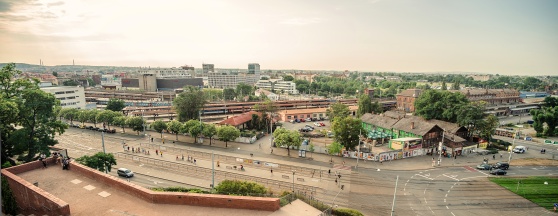
Trams to the relocated station in Brno would run longer than to the city center
 |
Brno - Trams would travel to the relocated station in Brno from a large part of the city longer than if the new main station were located in the center. This follows from a feasibility study of the modernization of the Brno railway junction. The study compared options with a station in the center, where the new station would be slightly shifted southwest from the current station, and in a relocated position, which would mean a new main station at the site of the current lower station. One part of the study was a description of the future public transport system for both variants. The difference in investments in urban transport infrastructure would be 1.6 billion; in the case of the relocated station, it would amount to 2.3 billion.
The current main station is at the brink of capacity and will not be sufficient for the growing demand for rail transport in the future; therefore, there has been discussions for several years on how to modernize the Brno junction and where to place the new station.
The completion of the necessary infrastructure is perceived by the study's creators as the biggest risk of the relocated station. The biggest risk of the center station variant is the lack of spatial planning documents and delays in their preparation.
For both station variants, it is common that a tram connection is planned between Stará osada and the line to Juliánov, with a connection of the Komárov line through Zvonařka and Masná streets to Křenová and a new line to the development area Štýřice-Vodařská. The development of the trolleybus network includes a line from Mendlovo náměstí cutting through around the hospital at St. Anne's to Hybešova street around the new station, connecting to the line to Slatina. The second major new trolleybus line is planned along Nová městská třída, which is intended to connect Zvonařka through a cut to Křenová, Cejl, and further along Příční and Traubova. This entails massive demolitions of existing buildings, and although it has been in the city's spatial plan since the 1960s, efforts exist to remove it from the spatial plan. The study states that the non-existence of this street would have an adverse impact on both new station variants, but it would affect the transport connection of the relocated station much more severely.
When building the relocated station, a tram hub would be created, from which the lines would lead toward the historic center, connecting at the Nové Sady stop or through Plotní street. Another line would head through Plotní to Masná and Křenová, and in another direction, trams would continue to the development area Štýřic. The model anticipates five lines without direct connections heading toward Bystrce, Stará osada, or Líšně via Novolíšeňská. Mendlovo náměstí is to be directly connected only by trolleybus. Except for Komárov, all tram routes to the station are longer, roughly as long as the current journey through the new connection from Křenová.
Trolleybuses would run from the station to Mendlovo náměstí, Hladíková, and along Nová městská třída toward Královo Pole and Olomoucká.
If the station were built in the center, the tram system would remain intact and be slightly expanded. A new line would run along Úzká street from Nové Sady to Plotní, thereby also facilitating access to the station from the south. Trolleybuses would also operate here, connecting the line from Slatina to Mendlovo náměstí. This variant is also calculating with the creation of a new bus station south of Malá Amerika, connected to both trolleybuses and buses.
The model also includes several new train stops integrated into public transport, with the most utilized one being at Černovická terasa.
Annual maintenance costs for infrastructure and operations are 36 million higher for the center compared to today, and 84 million for the relocated station.
The English translation is powered by AI tool. Switch to Czech to view the original text source.
4 comments
add comment
Subject
Author
Date
Městská veřejná doprava k novému brněnskému nádraží
Pavel Boucník
02.11.17 07:39
Komu slouží Zdeněk Meitner ČTK ?
Skála P.
02.11.17 11:22
Petrov
p. jorg
25.12.17 11:08
Studie proveditelnosti není objektivním hodnocením
Pražák
21.01.18 08:07
show all comments
Related articles
0
31.05.2018 | The relocation of the main train station to the river has been discussed in Brno for over 90 years
0
09.04.2018 | The Greens will turn to Minister Ťok due to the relocation of the train station in Brno
0
27.03.2018 | The steering committee recommended relocating the main train station in Brno
0
28.02.2018 | The zoning decision for the Brno railway station is delaying requests for interruption
3
31.01.2018 | Debates about the location of the train station in Brno have revived the question of the New City Boulevard
1
15.01.2018 | The Mayor of Brno, Vokřál, supported the construction of the train station in the relocated position
0
12.01.2018 | Supporters of the train station in the center of Brno criticize the region
4
10.01.2018 | Four expert evaluations recommend keeping the train station in the center of Brno
0
09.01.2018 | The Office of the City Architect recommends moving the train station to the Svratka
0
07.01.2018 | The leadership of Brno will conduct a public opinion survey regarding the train station
0
01.12.2017 | Green party calls on mayors from South Moravia to discuss the train station in Brno
0
30.10.2017 | The study admits the possibility of building a station in Brno at two locations
0
25.10.2017 | SŽDC will publish the results of the study on the reconstruction of the Brno junction
0
26.06.2017 | Politics wants to divide trains in Brno before the new main station is completed
0
10.05.2016 | Urban planners propose a gradual development of the area around the train station in the center












